2024 year in review: health and science
Health care access, workforce development at the forefront of local discourse
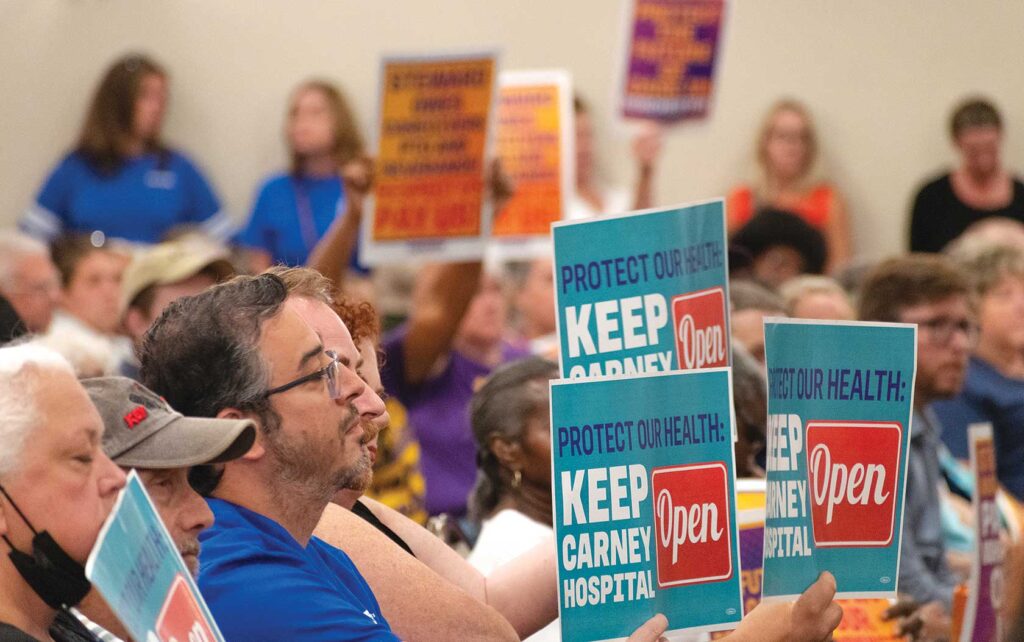
For residents in Boston and surrounding communities, 2024 saw heightened discussions about the closure of health care facilities and the elimination of health care resources, highlighting gaps that already existed in lower-income areas and communities of color.
The year also saw a continued push to ensure that, as science and technology fields grow, communities of color can make a place for themselves in that space.
Loss of health resources highlight gaps in care
Throughout 2024, Roxbury, Dorchester, Mattapan and surrounding communities grappled with the closures of a variety of health care resources and facilities.
That question of health care access — and places where it is limited — was one that wasn’t new to the city, said Bisola Ojikutu, executive director of the Boston Public Health Commission, but the loss of additional resources across the city highlighted needs that have long existed
Perhaps most prominently, in August, the ongoing saga of the embattled Steward Health Care’s presence in Massachusetts came to a head as Governor Maura Healey’s push to get the for-profit health care company out of the state led to the sale of six of the company’s eight functioning hospital campuses in early September.
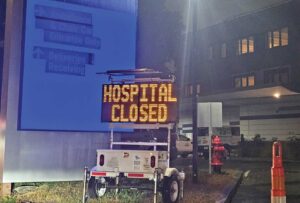
A digital sign outside of the shuttered Carney Hospital reminds passersby of the medical facility’s closing. PHOTO: JAMYRA PERRY/BAY STATE BANNER
But for Carney Hospital in Dorchester and Nashoba Valley Medical Center in Ayer, the end of the summer saw the end of operations as both facilities permanently closed when no “qualified bids” were found during court proceedings in a Dallas-based bankruptcy court.
The closure of the Dorchester hospital came despite protests from employees, patients and community members throughout the month of August, as Steward pursued a closure period of just over a month — condensed from the 120-day period that is outlined under state regulations.
At a state Department of Public Health hearing, held Aug. 13, supporters packed Florian Hall in Dorchester, filling more than three hours with testimony about what Carney meant to them.
Some told stories about how the hospital had helped and supported them and their loved ones; some presented data; and one supporter sang a song she had written about its role in the community. And speakers often wore more than one hat — staff and patients were often one and the same — as they extolled the community health and economic benefits of the facility that operated near Ashmont station.
Still, on Aug. 31, the facility shut its doors, leaving community members to travel further afield or face longer wait-times at other facilities — concerns that were highlighted throughout the closure process.
In response, the state launched a 34-member working group, led by Ojikutu and Michael Curry, president of the Massachusetts League of Community Health Centers, including health care experts, state and city officials and community advocates, the members of which were announced in October. A similar working group was assembled to address the closure of the Ayer hospital.
Since then, the group has met several times, including at a community meeting Dec. 12, looking to develop a plan for the how the area can address impacts from the closure and close gaps that existed in care before the hospital shut its doors.
Ojikutu said closure has highlighted disparities in things like preventable cancers, diabetes, heart disease and other factors that reduce life expectancy in the surrounding communities of Dorchester, Mattapan and parts of Hyde Park, which have long existed but have been exacerbated by the loss of the medical facility.
If there is any sort of silver lining to the closure, it is the fact that the working group, which is slated to issue its assessments in early 2025, now has the opportunity to consider the impact of the hospital closure and those gaps that existed before.
“I think that we’re at sort of a point where the fact that we have this one hospital that has closed … really gives us an opportunity to talk about these issues, to think strategically about what the real needs of this community in terms of access to care are,” Ojikutu said.
It’s a conversation that fits into a broader initiative the health commission announced this summer, called the Live Long and Well Agenda, focused on closing gaps in life expectancy in the city, spurred in particular by data released by the BPHC in 2023, which found a 23-year life expectancy gap between a census tract in Back Bay and another tract in Roxbury two miles away.
Ojikutu said the commission plans in January to issue a request for proposals to use a $10 million contribution from the Atrius Foundation to address economic mobility as it impacts health and life expectancy.
The campaign, as well as broader efforts from the health commission and in health advocacy circles in the Boston area, will focus on upstream factors — what public health experts call social determinants of health, things like housing, food security or the economic mobility at the heart of this first push — as a way to try to close health disparities and life expectancy gaps.
Months before the closure of Carney, across town in Roxbury, community members gathered in a falling January evening to protest the planned closure of the Warren Street Walgreens. Community action won a brief, two-week extension before the store shut down, but on Jan. 31 it closed, leaving an empty building and reduced access to the pharmacy services it provided.
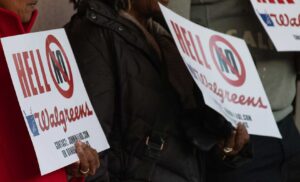
Community members protest the closure of the Warren Street Walgreens in Roxbury. PHOTO: AVERY BLEICHFELD/BAY STATE BANNER
The Warren Street Walgreens followed three other closures in Boston a little over a year before, all also in predominantly communities of color.
The closure raised concerns of a so-called “pharmacy desert” — though, city officials, acknowledging the impact of the closure, did identify six stores within a mile of the shuttered Walgreens.
Rev. Miniard Culpepper, senior pastor of the Pleasant Hill Missionary Baptist Church, said that the loss of the pharmacy may have shaken up the lives of community members, especially nearby elderly residents who now have added challenges in getting their prescriptions or receiving other care like vaccinations, especially with longer travel times that make it tough to get to other stores before they close.
“It puts us in [a] more vulnerable position, health-wise,” said Culpepper, who was at the center of the fight to keep the store open. “I can’t say we’ve lost lives because that Walgreens gone. I can say that it’s a threat to folks’ health.”
In the wake of the store shutting down, the Urban League of Eastern Massachusetts and the city of Boston announced plans to partner with Lyft to help close access gaps, a program that spun off into a broader program called the Holistic Health Initiative, which the Urban League launched in November.
Efforts like the one from the Urban League have helped, but not in a significant enough way, Culpepper said. Instead, he and the Communities of Color Coalition for Health Equity, which he helped organize to fight the closure, are now advocating a proposed ordinance in the Boston City Council that would require pharmacies and other health resources to provide 90 days’ notice before shutting down. Similar legislation was approved in the Massachusetts House of Representatives over the summer.
But 2024 also saw some victories in preserving or expanding care in Boston’s communities of color.
A fight led by community members and staff saw the Edgar Benjamin Healthcare Center on Mission Hill come under court-appointed receivership in April. The appointment of a receiver allowed the facility to continue operating after the center’s previous administrator, Tony Francis, announced plans in February to shut down the nursing home by the start of July.
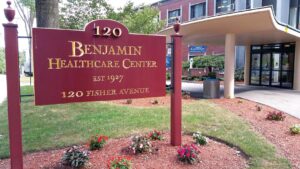
A fight led by community members and staff saw the Edgar Benjamin Healthcare Center on Mission Hill come under court-appointed receivership in April. PHOTO: COURTESY BENJAMIN HEALTHCARE CENTER
Francis, at the time, credited the need to close to “insurmountable financial difficulties,” but supporters of the facility were quick to point out a number of instances of alleged financial mismanagement, including botched cryptocurrency investments and personal loans from Francis to the facility at 12% interest, which left the Edgar Benjamin repeatedly unable to pay its employees.
Since Roxbury attorney Joseph Feaster took over as receiver in the spring, the center has increased its resident count, hired a new administrator and worked to get the facility back on track for continued operations with a goal making it to the Edgar Benjamin’s 100th anniversary in 2027.
On Dec. 19, Suffolk Superior Court Justice Anthony Campo ruled to extend the receivership by six months, until the end of June. The receivership, which was slated to end at the end of June under the original court order, was already extended once, through the end of 2024.
And residents in the South End also saw expanded care when NeighborHealth opened a new radiology suite at its community health center there. It was previously known as the South End Community Health Center before it merged with the East Boston Neighborhood Health Center. Previously, patients had to be referred to other facilities to get X-rays and mammograms, which now can be performed on site.
At the time of its opening, staff said they were hopeful the new space would increase access to care with faster appointments as they touted wait times of a week or two for mammograms, compared to the average of three months that existed citywide. Patients can get X-rays the same day as other medical care appointments at the facility.
City, state, community groups push for equitable growth of science workforce
Efforts to grow and diversify science and technology workforces continued to be a focus in the Boston area in 2024.
In February, the city of Boston announced $4.7 million in investments into life science workforce development programs, especially ones that will connect Black and brown residents with careers in biotechnology.
Those programs, along with much of the push more broadly, have focused on targeting efforts through programs other than four-year degree programs to meet more community members where they are.
Four of seven recipients of the $4.7 million in city funding were programs from community colleges or other schools with a focus on associate degree programs, like Franklin Cummings Institute of Technology. The other three centered external workforce development programs aim to get community members the training they need to access biotechnology jobs without another established degree.
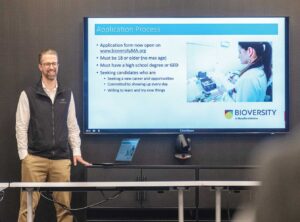
Bioversity Executive Director Zach Stanley addresses attendees at an information
session for the new initiative. BANNER PHOTO
For example, one of the recipients was Bioversity, a program that was launched in January through the Massachusetts Biotechnology Council, or MassBio — the training program is now officially an independent nonprofit — that runs eight-week programs from its classrooms in the Southline building in Dorchester.
Expanding workforce development programs, including through Bioversity, was identified as a priority by MassBio, the statewide trade group for the life sciences industry, in a five-year vision released by the group in October.
In September, Bioversity announced a planned expansion into the Merrimack Valley in partnership with the University of Massachusetts Lowell.
And more workforce development efforts are on their way. As part of a $4 billion economic development bond, a bill signed by Healey Nov. 20, the legislature OK’d $50 million in funding to the Nubian Square Life Science Training Center, which will be part of the Nubian Ascends development.
Richard Taylor, a leader of the Nubian Ascends development team, said that the training center is grateful for the state support and that the group is hoping to be in construction by the end of next year.
That economic development bond bill also included the third reauthorization of the Massachusetts Life Science Initiative, which, through the quasi-public Massachusetts Life Science Center, works to foster the biotechnology industry in the state.
Central to the push around workforce development will be coordinating between groups to maximize resources, leaders say. That’s why efforts like the Roxbury Worx initiative, run by The American City Coalition, have brought Roxbury groups, including the Nubian Square Life Science Training Center, together to jointly work on tackling the problem.
“All these orgs are working collaboratively because this is a big scope, a big lift,” Taylor said.
Opioid overdose deaths trended down
The city and state saw a glimmer of hope in the fight against the opioid epidemic in 2024.
In October, the Boston Public Health Commission announced preliminary data from the first four months of the year that showed a 33% decline in overdose deaths compared to the same period the year before, with notable decreases among Black and Latinx residents.
The announcement came after data released over the summer found that, statewide, overdose deaths dropped in 2023, but in Boston and among communities of color, deaths still rose.
“It really presents great news,” Ojikutu said. “We just have to figure out why it happened.”
Some of that, she said, might be due to the targeted investments the city has made in harm reduction and care.
A grant, announced by the city in the spring, directed $1 million to community-based organizations and offered funding in bundles of up to $200,000 intended to increase care in Boston, especially to communities of color. It marked a shift, Ojikutu said at the time, from focusing efforts at the intersection of Mass. and Cass, which had long been considered the epicenter of the epidemic in the city, to care across the city.
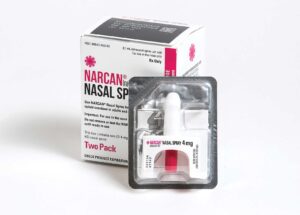
A priority of the city has been to increase access to naloxone, a medication often sold as Narcan, that can reverse the effects of an overdose. PHOTO: NEXT DISTRO/UNSPLASH
Another priority of the city has been to increase access to naloxone, a medication often sold as Narcan, that can reverse the effects of an overdose. The commission has made a push to get the drug out to more community organizations to distribute to residents.
That push has been occurring across the state and country. In 2023, Narcan became accessible over-the-counter in pharmacies nationwide. It was previously made accessible to anyone in Massachusetts under a standing order from the Department of Public Health in 2022.
And those changes may have had some effect. A study published in October found that a rising number of overdoses had been treated by laypeople administering naloxone before emergency medical technicians arrived at the scene.
“For a victim that’s experiencing an overdose, they can’t treat themselves. We have to get naloxone out into the community so those that are around them are able to take action,” said Rebecca Cash, an assistant professor of emergency medicine at Harvard Medical School and Massachusetts General Hospital, who worked on the study.






